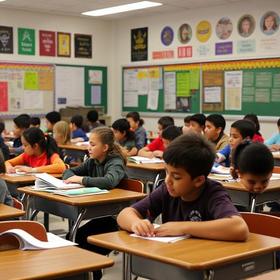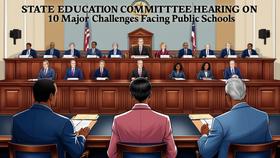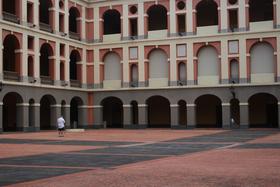Serving 754 students in grades Prekindergarten-5, Bain Elementary School ranks in the top 20% of all schools in North Carolina for overall test scores (math proficiency is top 20%, and reading proficiency is top 20%).
The percentage of students achieving proficiency in math is 76% (which is higher than the North Carolina state average of 51%). The percentage of students achieving proficiency in reading/language arts is 61% (which is higher than the North Carolina state average of 50%).
The student-teacher ratio of 18:1 is higher than the North Carolina state level of 15:1.
Minority enrollment is 43% of the student body (majority Black and Hispanic), which is lower than the North Carolina state average of 57% (majority Black).
Quick Facts (2025-26)
- Grades: Prekindergarten-5
- Enrollment: 754 students
- Student-Teacher Ratio: 18:1
- Minority Enrollment: 43%
- Overall Testing Rank: Top 20% in NC
- Math Proficiency: 76% (Top 20%)
- Reading Proficiency: 61% (Top 30%)
- Science Proficiency: 80-84% (Top 20%)
- Source: National Center for Education Statistics (NCES), NC Dept. of Education
Top Rankings
Bain Elementary School ranks among the top 20% of public schools in North Carolina for:
Category
Attribute
Overall Rank
Math Proficiency
Science Proficiency
School Overview
Bain Elementary School's student population of 754 students has declined by 19% over five school years.
The teacher population of 43 teachers has declined by 18% over five school years.
Grades Offered
Grades Prekindergarten-5
(No virtual instruction)
(No virtual instruction)
Total Students
754 students
Gender %
Total Classroom Teachers
43 teachers
School Rankings
Bain Elementary School ranks within the top 20% of all 2,617 schools in North Carolina (based off of combined math and reading proficiency testing data).
The diversity score of Bain Elementary School is 0.63, which is less than the diversity score at state average of 0.71. The school's diversity has stayed relatively flat over five school years.
Overall Testing Rank
#442 out of 2617 schools
(Top 20%)
(Top 20%)
Math Test Scores (% Proficient)
(21-22)76%
51%
Reading/Language Arts Test Scores (% Proficient)
61%
50%
Science Test Scores (% Proficient)
80-84%
63%
Student-Teacher Ratio
18:1
15:1
American Indian
n/a
1%
Asian
7%
4%
Hispanic
13%
21%
Black
17%
25%
White
57%
43%
Hawaiian
n/a
n/a
Two or more races
6%
6%
All Ethnic Groups
Participates in the National School Lunch Program (NSLP)
Yes
Eligible for Free Lunch
30%
68%
Eligible for Reduced Lunch
2%
1%
School Statewide Testing
School District Name
Source: National Center for Education Statistics (NCES), NC Dept. of Education
Profile last updated: 02/09/2025
Frequently Asked Questions
What is Bain Elementary School's ranking?
Bain Elementary School is ranked #442 out of 2,617 schools, which ranks it among the top 20% of public schools in North Carolina.
What schools are Bain Elementary School often compared to?
Bain Elementary Schoolis often viewed alongside schools like Queen's Grant Community School, Clear Creek Elementary School by visitors of our site.
What percent of students have achieved state testing proficiency in math and reading?
76% of students have achieved math proficiency (compared to the 51% NC state average), while 61% of students have achieved reading proficiency (compared to the 50% NC state average).
How many students attend Bain Elementary School?
754 students attend Bain Elementary School.
What is the racial composition of the student body?
57% of Bain Elementary School students are White, 17% of students are Black, 13% of students are Hispanic, 7% of students are Asian, and 6% of students are Two or more races.
What is the student-teacher ratio of Bain Elementary School?
Bain Elementary School has a student ration of 18:1, which is higher than the North Carolina state average of 15:1.
What grades does Bain Elementary School offer ?
Bain Elementary School offers enrollment in grades Prekindergarten-5 (No virtual instruction).
What school district is Bain Elementary School part of?
Bain Elementary School is part of Charlotte-Mecklenburg Schools.
School Reviews
1 10/10/2025
This school is basically all rich white kids. My son has had nothing but problems with bullying since we moved to this school. He hates it and begs us to move back to where we lived before. The school is overcrowded and there is obviously the only thing that really matters are ratings and test scores. There is no child-based learning programs, or STEM programs at this school. Why on earth hasn't this school caught up with the flexible learning programs that are offered at so many other schools in CMS? Don't send your kids here if you're looking for any sort of diversity or culture.
5 10/10/2025
I'm not sure what the other review means by no STEM programs...My daughter has had STEAM weekly for 2 years at Bain. Along with Art, Music, Library, and PE. I feel like there is a big focus on sciences and arts along with math and reading. Judging a school during the year of Covid doesn't seem too fair, but I think schools all did the best they could. My daughter has enjoyed her time there so far and we're happy to be able to live in Bain zoning. We moved to the area so she could go to Bain. It's like a free private school education in my opinion. And I'm not sure what the other reviewer means by rich white kids. Yes, there are a lot of white children at Bain. However, in both my daughter's K and 1st-grade classes, there was a diverse mix of students ranging from black, white, Hispanic, Indian, Russian, and so on.
Review Bain Elementary School. Reviews should be a few sentences in length. Please include any comments on:
- Quality of academic programs, teachers, and facilities
- Availability of music, art, sports and other extracurricular activities
Recent Articles

How Public Schools Support Students on Free / Reduced-Lunch Programs
Explore how U.S. public schools support students eligible for free or reduced-price lunch through nutrition, academic, and wraparound services in 2025.

Hidden Costs of Public Schools: Fees, Supplies & Extras
Explore the hidden costs in public schools—fees, supplies, extracurriculars—and how parents can plan for them in 2025.

Public School Funding 2025: What Families Should Know
Essential insights on public school funding in 2025—how it works, what’s changing, and what families should know to stay ahead.





